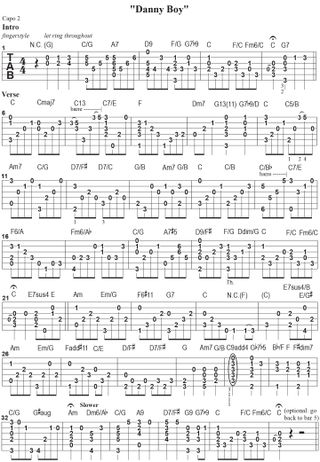How to Play a Solo Guitar Arrangement of “Danny Boy”
In the spirit of St. Patrick’s Day, I offer my solo guitar arrangement of “Danny Boy,” that beautifully sad and ever-popular Irish ballad that’s proudly sung by Irish-Americans in taverns across the U.S. every March 17, the lyrics to which were written over 100 years ago by Frederic Weatherly (who was actually an Englishman) and set to the ancient Celtic melody “Londonderry Air.”
My arrangement of the tune grew out of a vocal accompaniment that I’ve refined and re-harmonized over the years. I’ve modified it here to include all the melody notes on top of each chord voicing and present it as a stand-alone instrumental. I perform the arrangement fingerstyle, as if it were in the key of C, and with a capo at the second fret, which transposes everything up a whole step to the key of D.
The challenge with crafting a chord-melody arrangement of any tune is to emphasize and try and keep the focus on the melody and phrase it as if you were singing the words, while also providing a pleasing harmonic backdrop and clear rhythmic pulse. It’s important to try and keep the melody above the chords, bass notes or arpeggios, in terms of the pitches, so that it doesn’t get lost within the accompaniment or overshadowed by it.
Sometimes, a section of a melody will be purposely transposed down an octave, as I’ve done here, in bars 21–31, in order to keep the highest notes in a manageable range and, as a result, some melody notes may dip into the lower register and almost crowd-out the accompaniment, as occurs in bar 28, where the ringing open D note is the melody.

The piece should be performed slowly, freely and expressively, meaning you can momentarily slow down or pause when transitioning between phrases, as if to take a breath. And definitely incorporate volume contrasts, or dynamics, starting out softly and swelling to full volume going into bar 22, for the chorus, then bringing it back down to a whisper for the final four bars. Try to allow the notes within each chord to ring together when possible, and carefully avoid sounding any unwanted notes with either hand. There are several spots, specifically in bars 5, 7, 10, 12, 16, 17, 19 and 30, in which I’ve indicated a barre, thumb fretting or specific fingering you’ll need to employ in order to perform the passage smoothly and with the notes ringing together.
The harmonically rich and surprising C9sus4 chord in bar 30 is a move I copped from an old friend and former bandmate, the brilliantly daring pianist, composer and arranger Jan Stevens. If you prefer, you can substitute a regular first-position C7 chord here, which makes for an easier transition to the Gb7b5 tri-tone substitution that follows.
Have fun playing the arrangement, and feel free to move the capo around, or not use one at all. Cheers!
Get The Pick Newsletter
All the latest guitar news, interviews, lessons, reviews, deals and more, direct to your inbox!
Over the past 30 years, Jimmy Brown has built a reputation as one of the world's finest music educators, through his work as a transcriber and Senior Music Editor for Guitar World magazine and Lessons Editor for its sister publication, Guitar Player. In addition to these roles, Jimmy is also a busy working musician, performing regularly in the greater New York City area. Jimmy earned a Bachelor of Music degree in Jazz Studies and Performance and Music Management from William Paterson University in 1989. He is also an experienced private guitar teacher and an accomplished writer.







![Joe Bonamassa [left] wears a deep blue suit and polka-dotted shirt and plays his green refin Strat; the late Irish blues legend Rory Gallagher [right] screams and inflicts some punishment on his heavily worn number one Stratocaster.](https://cdn.mos.cms.futurecdn.net/cw28h7UBcTVfTLs7p7eiLe-840-80.jpg)



